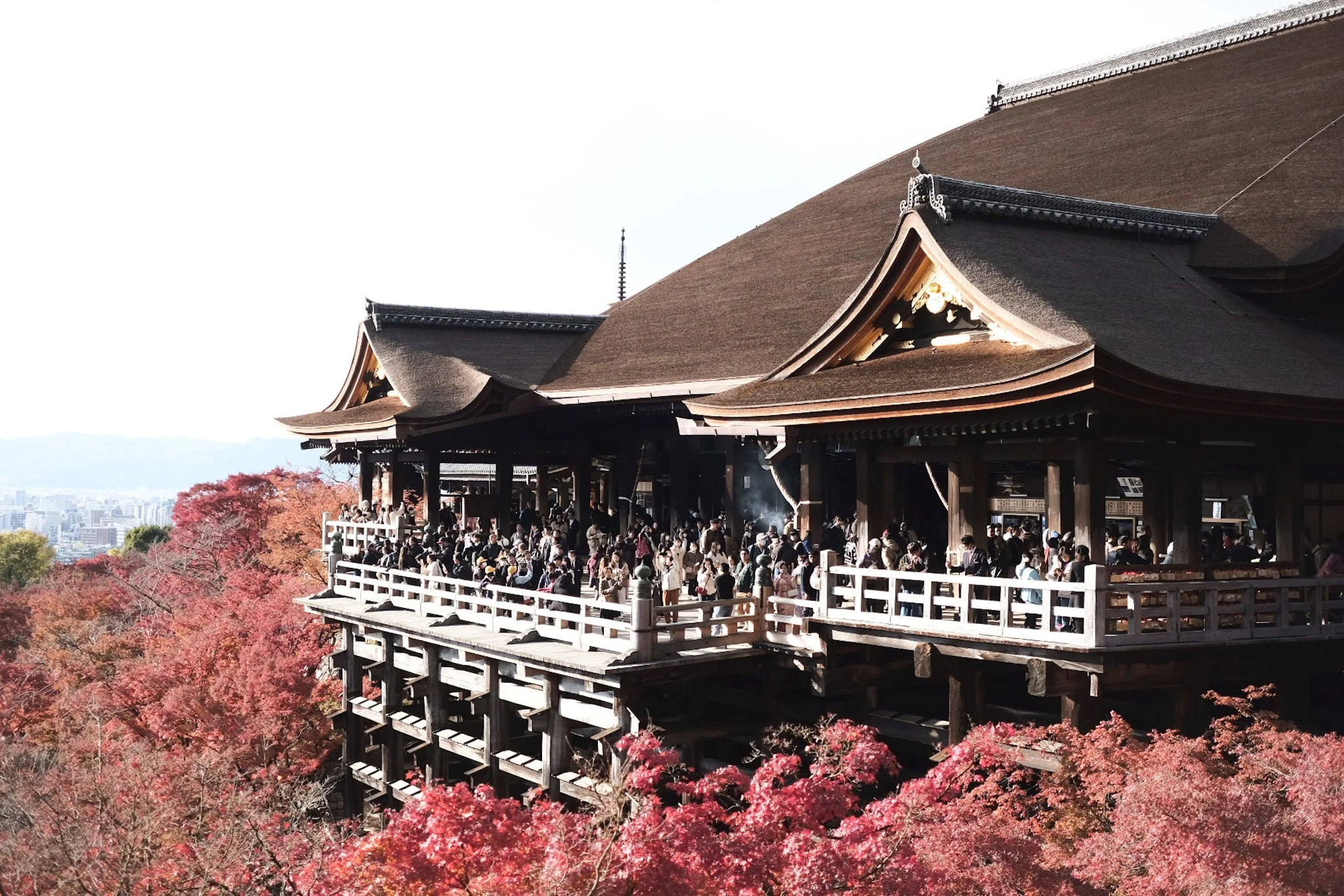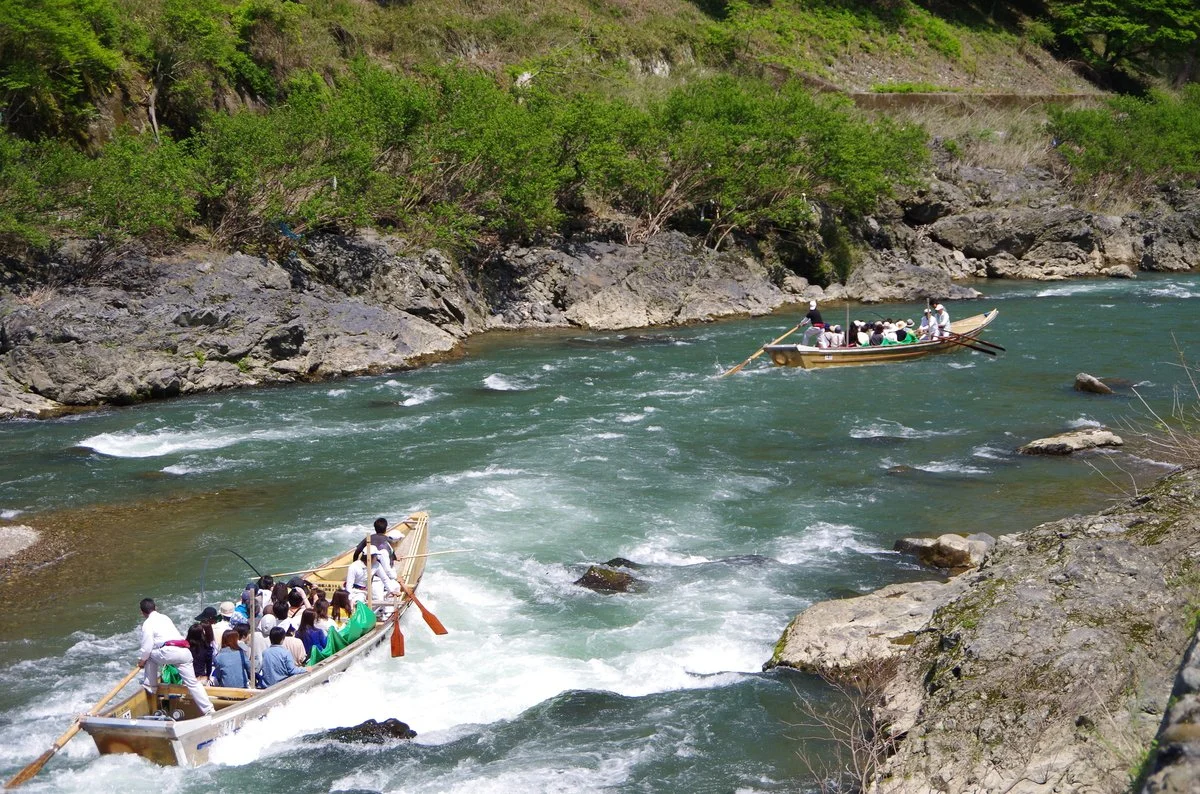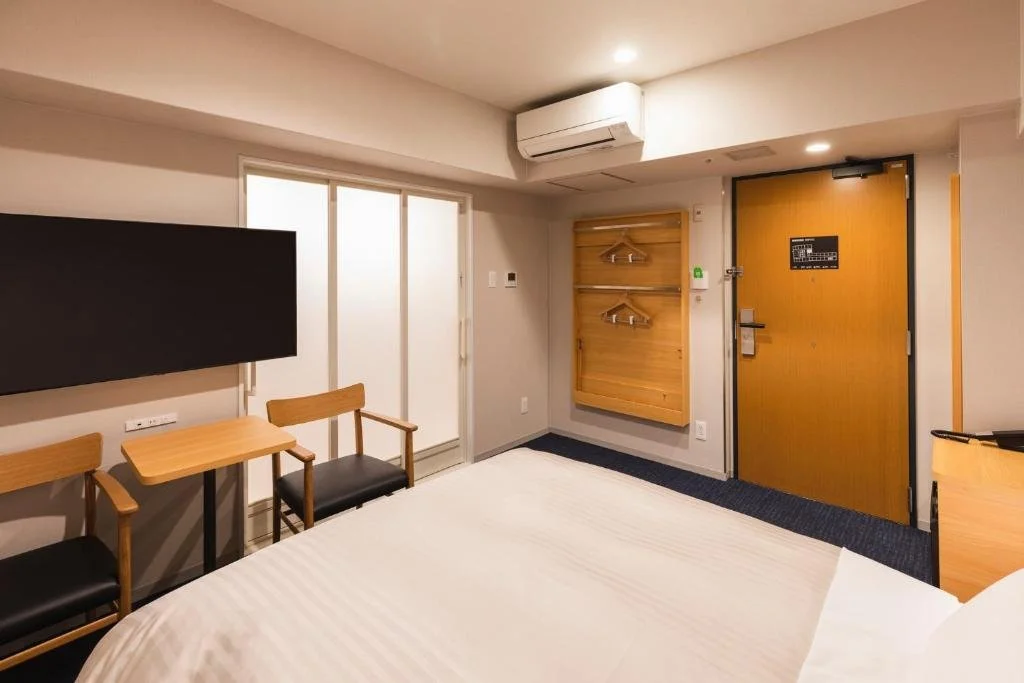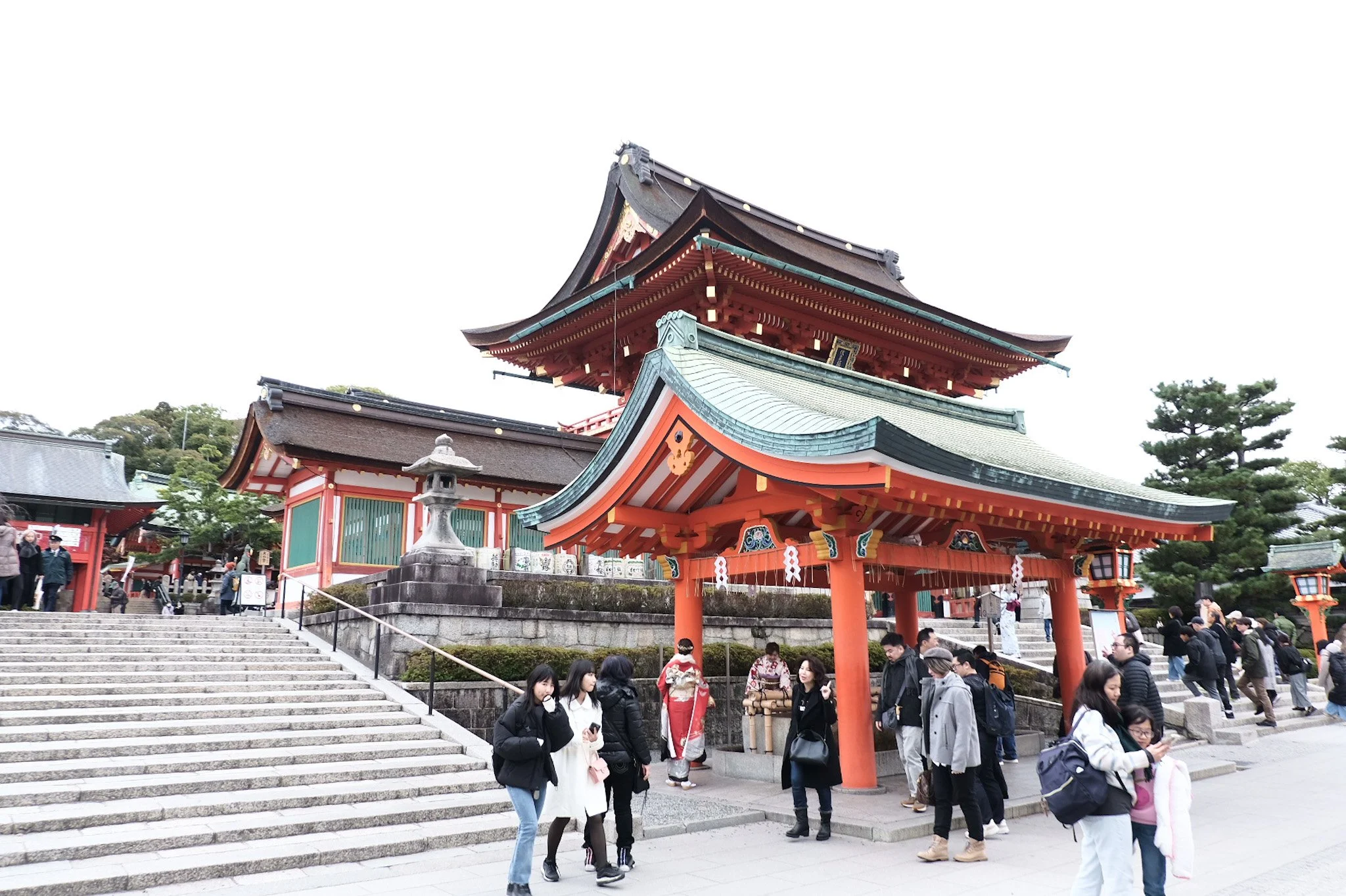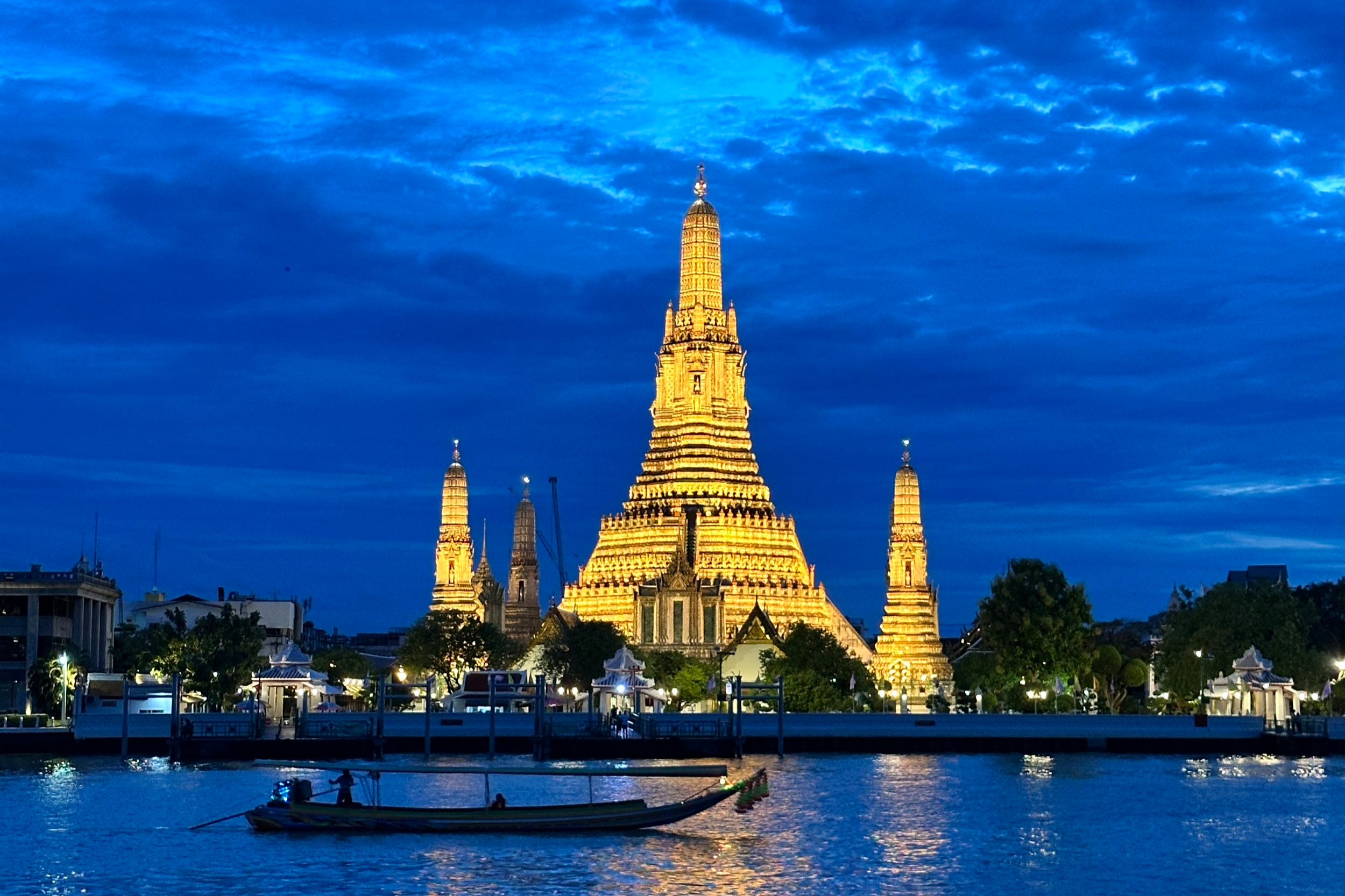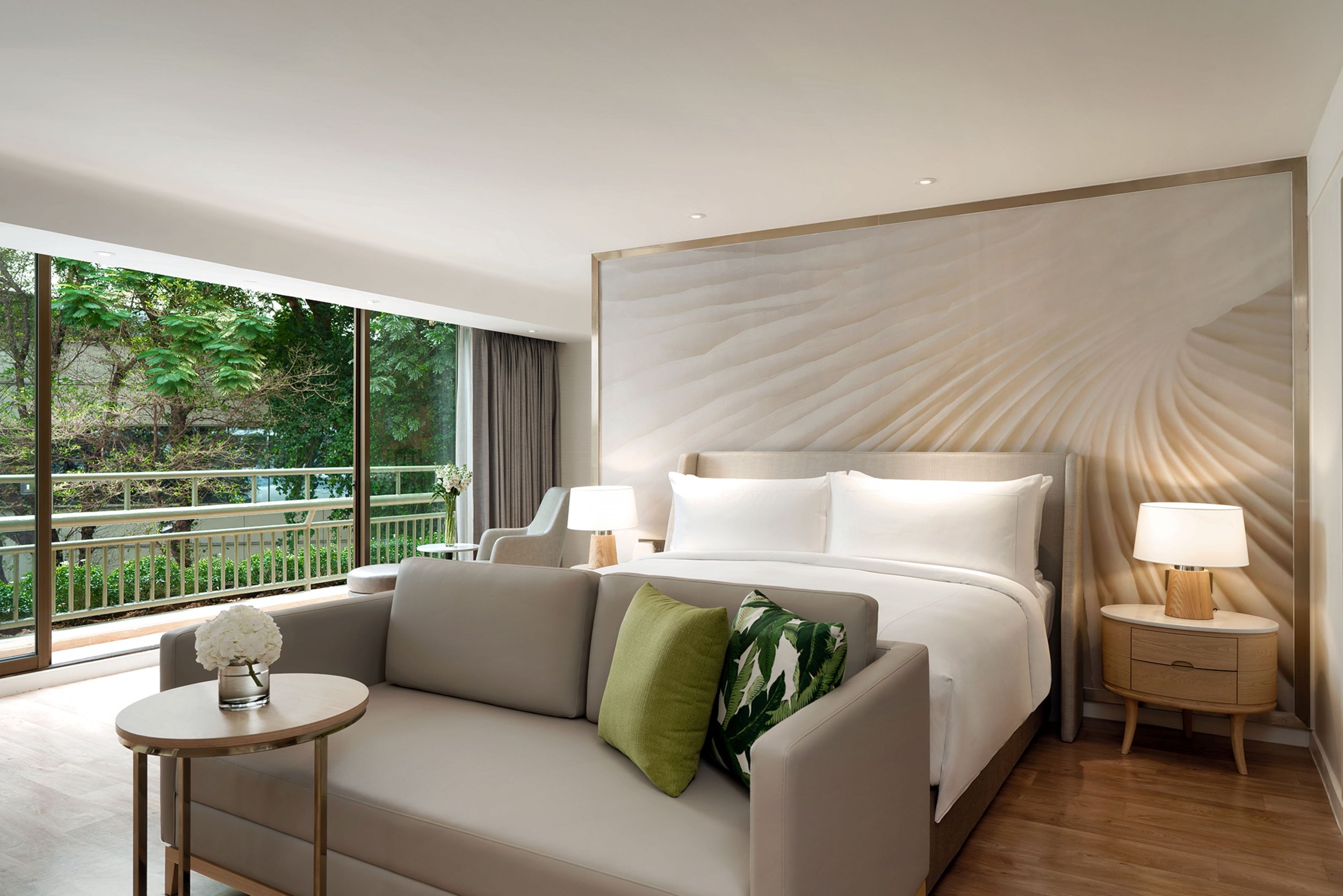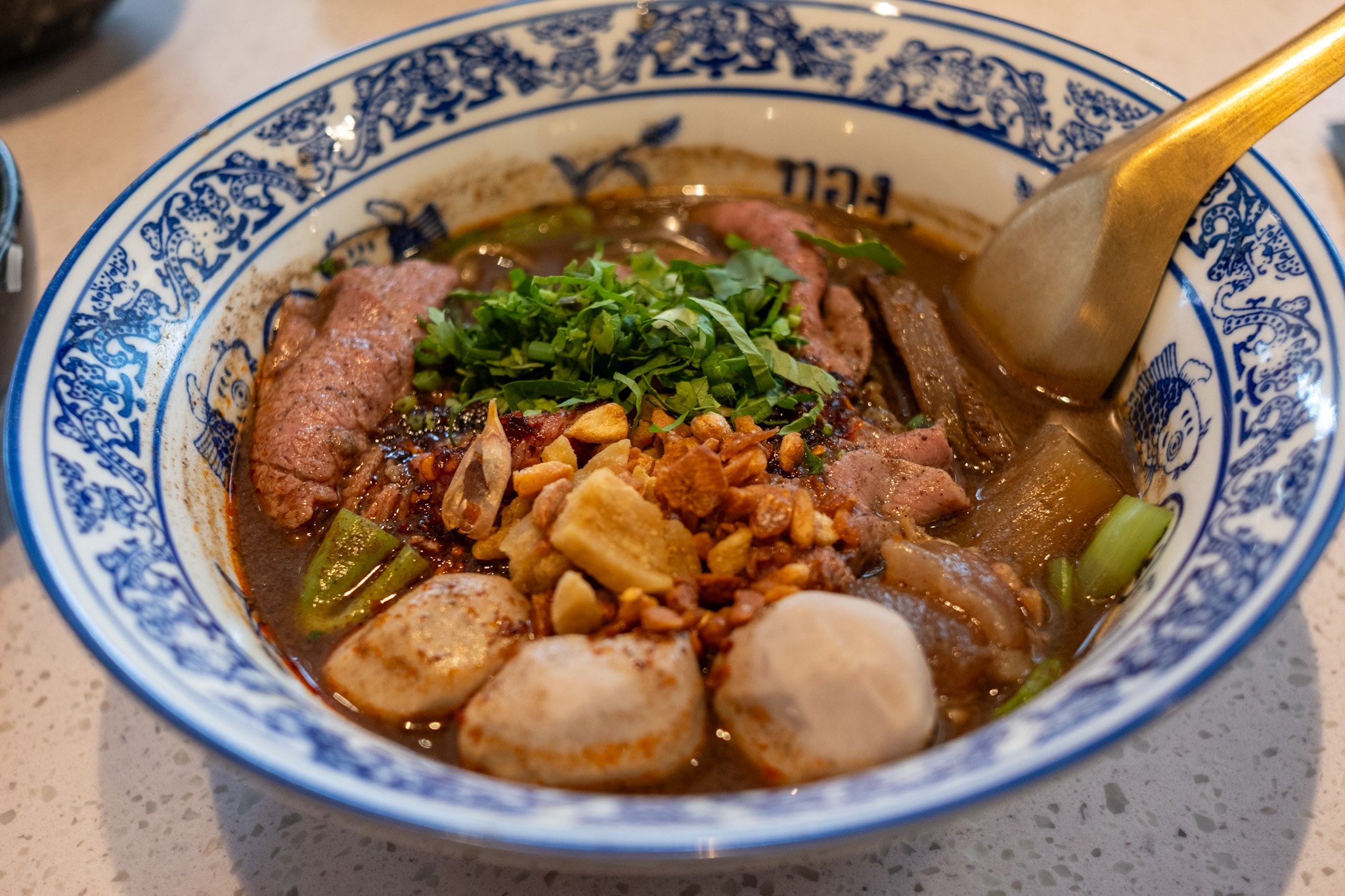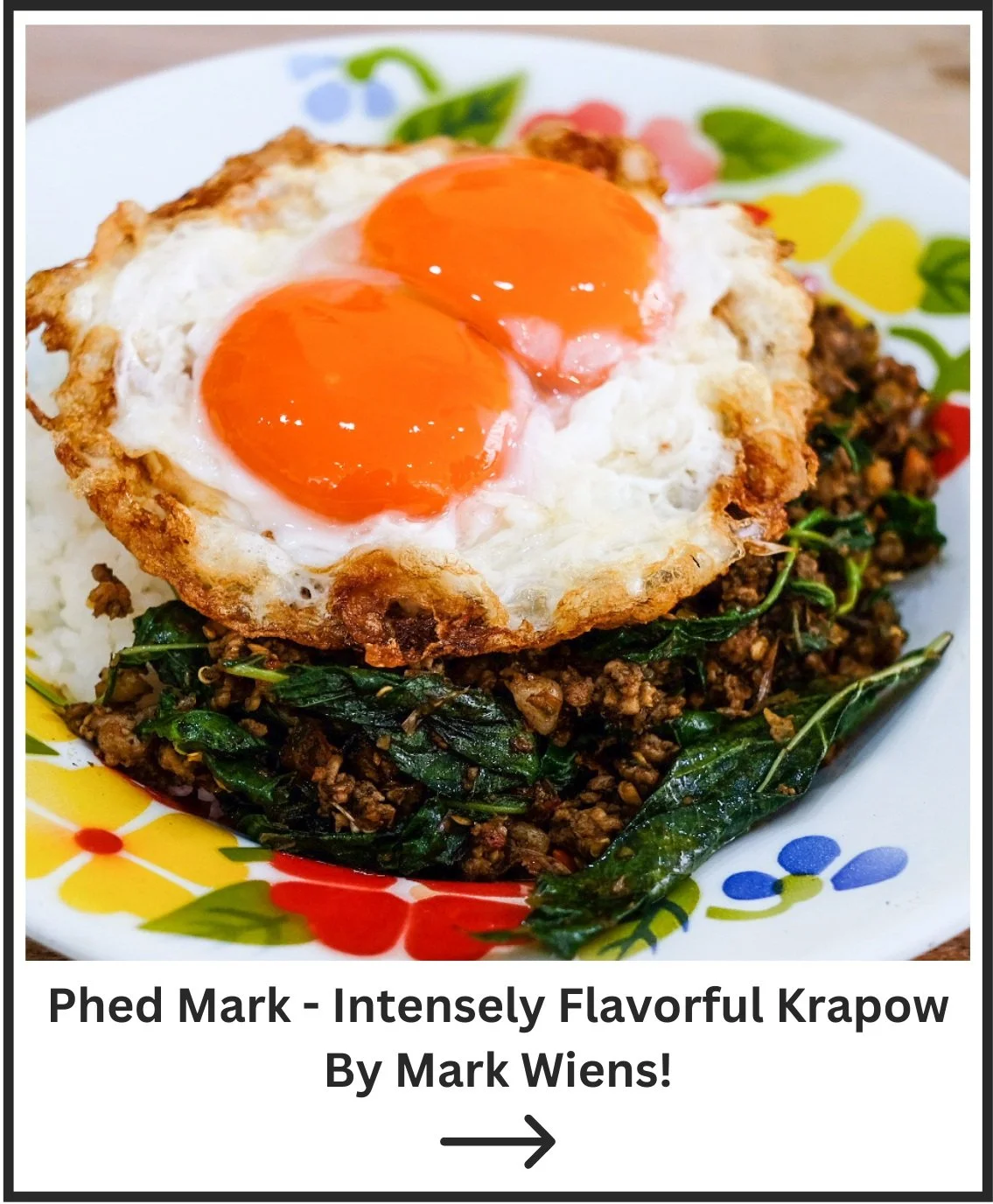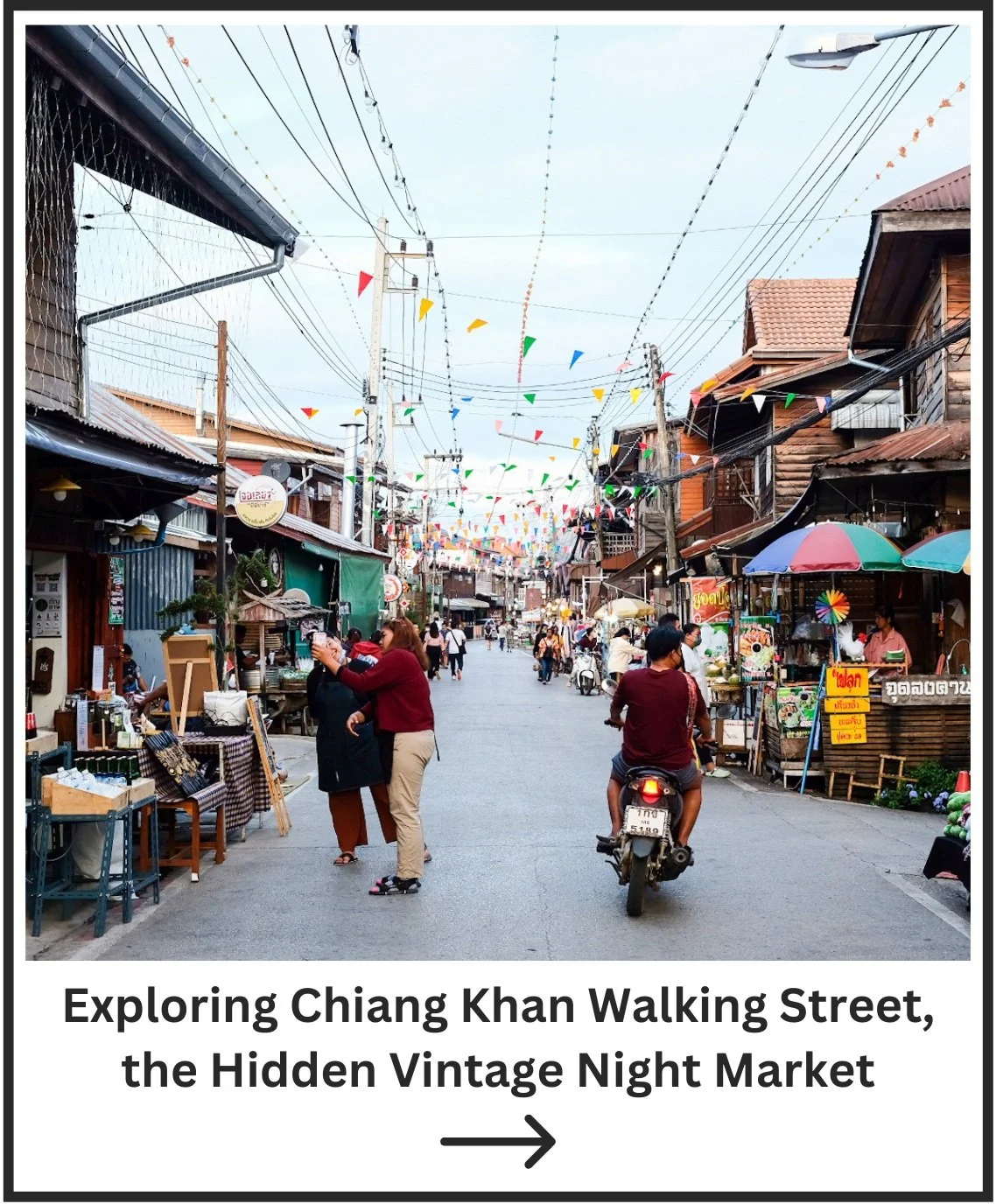Amazing 3 Day Kyoto Itinerary, Things to Do in Japan’s Ancient Capital!
One of the Pagodas at Kiyomizu-dera
Kyoto is a beautifully historical and cultural city that is just a short 30 minute Shinkansen train ride away from Osaka (Check out my Osaka Itinerary, if you’re planning a trip), so it’s perfect for a quick day trip from Osaka, or if you really want to fully explore Kyoto and all this city has to offer, then perhaps you'll want to follow my 3 Day Kyoto Itinerary!
From hiking up a mountain path covered by thousands of Torii gates at the world famous Fushimi Inari Taisha Shrine, to witnessing an ocean of Sakura cherry blossoms at the Kiyomizu Dera Temple. I’ve planned this Kyoto Itinerary to include all the best things to do in Kyoto, areas to stay, travel tips, as well as the best spots to sample some delicious Kyoto street food, this is Feastography after all, filling your stomachs is important!
So if you’re ready, let me bring you on a fun excursion throughout The City of Flowers, in my amazing 3 day Kyoto itinerary!
Check out my other Kyoto blog posts!
Affiliate Disclaimer: This page contains affiliate links. By clicking on the links and purchasing the product, I will receive a partial commission at no cost to you. All of these products are ones that I fully trust and recommend with my heart. Thank you for your support!
Your 3 Day Kyoto Itinerary at a Glance
If you’re short on time or can’t be bothered to read my blog post (I understand), here’s a quick breakdown of how I’ve structured this 3 Day Kyoto Itinerary, plus a few useful pointers to help you get a better understanding of what we’ll be doing and how you can plan your Kyoto Itinerary. Basically, Kyoto is filled with ancient temples, and many hidden culturally significant streets, you visit Kyoto to mainly learn about the history of Japan, it was after all, the ancient capital of Japan. This itinerary to keep things balanced, making sure you experience all the must-see highlights without feeling rushed.
So anyways, Here’s a quick breakdown of my 3 Day Kyoto Itinerary:
Day 1: Sightseeing at Kiyomizu-Dera Temple, Ninenzaka Shopping Street, the Geisha District
Day 2: Hiking Fushimi Inari Taisha, Eating Through Nishiki Market, Watching Kabuki Show
Day 3: Arashiyama Bamboo Grove, Interacting with Monkeys, Golden Kinkaku-ji Temple
Here are some brief pointers for Kyoto that you can check out first:
Flight Deals: I use Kiwi.com to find the best flight deals for all my international travels.
Accommodations: I book all my hotel stays on Agoda, for the best deals.
Travel Insurance: Travel worry free with My Go-to Travel Insurance.
Data & Sim: Stay connected while traveling with this Japan eSim!
Useful Apps: Must have apps in Japan are Grab, Google Maps.
Tours & Activities: Find the best things to do in Japan via GetYourGuide, Viator, and Klook.
Of course you don’t have to follow my 3 Day Kyoto Itinerary, if you have things to do in Kyoto that I haven’t covered in my itinerary, feel free to change or modify it to fit your schedule! On that note, you can download my 3 Day Kyoto Itinerary for Free by joining my newsletter below!
Best Time to Visit Kyoto, Japan
Spring in Japan is when the cherry blossoms bloom!
So when is the best time to visit Kyoto? The good news is that Kyoto is absolutely gorgeous at all times of the year. For example, in Spring you can expect the iconic Sakura Cherry Blossoms to bloom, in Summer are lively festivals, Autumn is great weather for exploring, and of course winter is the time of snow.
Personally, I always travel to Kyoto during the Spring, during the peak season for the blooming Sakura Cherry Blossoms, however it’s also the season where there’s lots of tourists so you might now like that. Anyways that’s just my opinion, I’ll go over the seasons in Kyoto in more detail so you can plan for Kyoto Itinerary to fit your needs.
Visiting Kyoto in Spring/Summer
The Hozugawa River Boat Ride, a popular thing to do in Kyoto during summer
Spring (March - April) is one of the best times to visit Kyoto due to the aforementioned blooming of the Sakura Cherry blossoms. In fact, it’s the best time to visit anywhere in Japan due to that very reason. The city will be covered in red and pinkish leaves and if you’re at one of the many popular sightseeing spots for cherry blossoms like Maruyama Park, or the grounds of Kiyomizu-dera Temple then you’re in for a real spectacular treat.
In terms of weather, expect it to range around 12-18°C (54-64°F), for me, that’s very nice weather for a exploring, but bring a jacket just in case. Spring is peak tourism season in Kyoto so I recommend getting your hotel bookings in order for your Kyoto Itinerary since rooms can sell out quickly. Sites like Agoda often have better prices and deals for earlier bookings.
Summer (May - August) in Kyoto is hot. If you’re traveling from Equatorial countries like my South East Asian friends, then you know how hot the weather can get. Temperatures often reach 35°C (95°F), so be sure to pack sun screen, and breathable clothing. Although it ain’t too bad because there is often light breezes. July is especially lively with the famous Gion Matsuri, one of Japan’s biggest and oldest festivals, where you’ll see elaborate parades and traditional floats throughout Kyoto. Also one summer activity that I really enjoyed was this Hozugawa River Boat Ride, perfect for cooling off in summer.
Visiting Kyoto in Autumn/Winter
Take a peep at the Kinkaku-ji during the winter, beautiful!
Autumn (September - December) is also a good time to visit for your Kyoto Itinerary. Instead of the bright reds and pinks of the cherry blossoms, you see warm oranges, yellows, and gold. Again the Kiyomizu-dera Temple is a great sightseeing spot for the autumn foliage, but the Arashiyama Bamboo Grove is also amazing to explore during this time of year. The weather is cool and comfortable, ranging from 10-18°C (50-64°F), so just a bit colder compared to Spring.
Winter (December - February), is surprisingly quiet in Kyoto, though still nice to visit. The weather is a bit harsher with temperatures going as low as freezing while barely reaching double digits 0-8°C (34-46°F) usually there isn’t any serious snowfall (though it can happen), you can expect the streets to be covered pockets of a thin layer of snow and ice. Places like the Golden Pavilion (Kinkaku-ji) can be seen covered in a puffy layer of snow, but you’ll have to be quick cause the snow melts away fast. Winter is also the season for Kyoto's illuminations, where gardens and temples light up via LED lights in the evenings. Overall, if you prefer fewer crowds and crisp weather, winter is a great time to visit for your 3 Day Kyoto Itinerary.
Getting to Kyoto by Shinkansen Train
An iconic form of transportation that embodies the efficiency and technological prowess of Japan
The closest airport to Kyoto is the Kansai International Airport in Osaka, which is still quite a bit away, approximately 25 minutes away via train. So Unless you intend to mostly travel around Osaka (my Osaka Itinerary includes day trips to Kyoto), then it would make sense to travel to Kyoto via railway like on the Shinkansen bullet train, the icon of Japanese civil engineering, and something that you must experience for your Kyoto Itinerary.
I’ll assume you’ll be traveling from Tokyo to Kyoto, but this works for any destination in Japan, especially Osaka, since Kyoto is a popular city for day trips from there. The Shinkansen is by far the fastest and most convenient option. You will need to purchase a ticket for the Shinkansen Hikari train on the Tokaido Shinkansen Line which will run you about 13,800 JPY, If you happen to have a JR Pass (Purchase online here) then you won’t need to purchase a ticket as it is already included, just book a seat at the JR service counter any of the railway stations.
You’ll want to board your train at the Tokyo Station OR the Shinawaga Station, whichever one is closes to your hotel, and then hop off at Kyoto Station, easy peasy!. The journey from Toyko to Kyoto via Shinkansen is roughly 2 hours and 15 minutes. From Osaka to Kyoto it’s 25 minutes.
If you don’t already have a JR Pass, I highly recommend looking into one, you can easily purchase it online through Klook, and it can save you a lot if you’re planning to explore more of Japan by it’s extensive railway network.
Best Hotels in Kyoto, and Where to Stay?
The good thing is, while rooms are small, they’re still bigger than lot of hotels in Tokyo…
You’ll want to choose your hotel carefully for your Kyoto Itinerary, because we are going to be doing a lot of walking and exploring and it’s important to have easy access to transportation options like the local train stations for example.
However, Kyoto has a nice variety of districts to suit different travel styles. Areas like Gion, Higashiyama, and Kawaramachi for example, are perfect if you want to stay close to traditional streets, historic teahouses, and authentic local dining spots. I’ll go over the districts below and then provide you with my recommendations for hotels in Kyoto:
Districts and Neighbourhoods of Kyoto, Where to Stay?
Gion - Historic Geisha district with lantern lit streets, teahouses, and oozing with culture. Best area exploring traditional Kyoto.
Higashiyama - Scenic temple district with historical shopping streets (Ninenzaka, Sannenzaka) and nearby famous attractions like Kiyomizu-dera Temple and the Fushimi Inari Taisha shrine
Shijo-Kawaramachi (Downtown) - Modern central area with shopping, restaurants, Nishiki Market, and nightlife.
Kyoto Station Area - Major transport hub with modern hotels, easy train and bus connections, ideal for first-timers and the area where I stayed at.
Arashiyama - Natural escape, famous for the Bamboo Grove, Monkey Park, and riverside views. Peaceful, but I wouldn’t recommend staying here unless it’s a quick overnight getaway.
My hotel recommendations for your 3 Day Kyoto Itinerary
Daiwa Roynet Hotel Kyoto Ekimae PREMIER - Right across from Kyoto Station, modern and spacious rooms, perfect for easy access to trains, buses, and day trips.
APA Hotel Kyoto-Eki-Horikawadori - Budget-friendly chain hotel, reliable, compact rooms with all the essential amenities, where I stayed at.
Sotetsu Fresa Inn Kyoto-Kiyomizu Gojo - Clean, comfortable, and located near Gojo Station, easy access to Geisha District, Kiyomizu-dera, and central Kyoto’s main attractions.
Ryokan Shimizu - Exceptionally good vlaue ryokan with a private onsen bath
Ryokan Izuyasu - Luxury ryokan serving traditional Kyoto cuisine and dining options
Day 1: Kiyomizu and the Geisha District
The west gate of the Kiyomizu-dera
Goooooood morning and welcome to your first day in this 3 Day Kyoto Itinerary! Today I’ll be bringing you to explore the historical and cultural side of Kyoto, more specifically, we’re going to the most popular tourist attraction in the city, the Kiyomizu-dera, the Pure Water Temple. And in the evening we’ll be heading to the Geisha District of Gion to learn more about what life was like back in Heian Japan.
So be sure to pack some good shoes, and an umbrella if you’re here during the summer, because we’'ll be doing quite a bit of walking and exploration!
Morning: Sightseeing the Ocean of Cherry Blossoms at Kiyomizu-dera
The iconic Hondo main hall of Kiyomizu-dera
Welcome to the Kiyomizu-dera temple, one of the most famous landmarks to visit in Kyoto, you haven’t been to Kyoto if you didn’t come to this temple. You’ll notice that on the walk up to Kiyomizu-dera is a walking street, that’s the Ninenzaka and Sannenzaka street, we’ll come back to it later cause we’re being strategic, Kiyomizu gets really crowded and we’ll want to beat the crowds, ideally we want to be there around 8:00 AM.
This UNESCO World Heritage Site opens daily from 6:00 AM to 6:00 PM, and has an entry fee of 400 JPY (~$2.50 USD). The temple is a complex where the main hall overlooks an ocean of cherry blossoms, during Spring, the cherry blossoms will be bright red/pink making for a literal sea of red when you look out into the distance.
The most striking piece of architecture in Kiyomizu-dera (check out my blog about Kiyomizu-dera too) is the main hall (Hondo) as it’s supported by large wooden logs and the amazing thing is that this hall along with the supporting structure is constructed without any nails, nuts, and bolts! That is insane to think about, especially when you see the structure with your own eyes.
At the base of the temple is also the Otowa Waterfall of which the temple is named (Pure Water Temple) after. The waterfall’s 3 streams intersect at Kiyomizu-dera and it is here where you can drink from streams with each blessing you with health, success, or love. However, you mustn’t be greedy, as tradition dictates you must ONLY PICK ONE… Comment below on which one you’ve picked, I chose success :)
Afternoon: Exploring the Ancient Ninenzaka and Sanenzaka Alleyways
Sannenzaka street is always packed full of tourists
Right, after ogling at the cherry blossom ocean, our next stop in today’s Kyoto Itinerary is to head back down the temple and enjoy our time at the historical Ninenzaka and Sannenzaka alleyways. These historic stone paved streets are lined with traditional wooden houses, souvenir shops, cafés, and street food stalls. And it’s just a wonderful time to stroll through.
It’s even better to waltz through if you are wearing a kimono, I know it’s very touristy but it’s fun! Have some fun. There are numerous Kimono rental shops throughout Kyoto, but this one shop, Okimono, located near Kiyomizu-dera is a popular one. They offer an all day rental with 500 dresses in all sizes, make up and hairstyling service, as well as an optional photographer. Check it out, it’s a very fun experience.
Anyways, as a foodie Ninenzaka and Sannenzaka is a joy to explore, there are street food stalls selling all kinds of traditional foods like the sesame pickled cucumbers, Yatsuhashi, a famous Kyoto snack made of soft mochi with sweet fillings, various Matcha flavored snacks (Kyoto is famous for Matcha) and modern foods like donuts and soft cream (the Japanese word for ice cream). You can also stop by Starbucks Ninenzaka, known for being one of the few Starbucks in the world housed inside a traditional Machiya Townhouse.
Evening: Live like a Geisha at Gion Neighborhood, the “Geisha District”
The Geisha district is like a snippet from the past
Finally for your evening in our first day of our 3 Day Kyoto Itinerary, I’ll be bringing you around Gion, the Geisha District. This area comes alive after dark and the he most popular street to explore is Hanamikoji Street, lined with traditional tea houses, traditional wooden houses, and exclusive restaurants.
If you’re lucky, you might spot a geisha or maiko (apprentice geisha) walking quietly between tea houses, though remember to be respectful and avoid being a nuisance. Beyond geisha spotting, Gion is packed with hidden gems like Yasaka Shrine, which stays illuminated in the evenings, and the nearby Shirakawa Canal, one of the most scenic spots for a peaceful night stroll.
There is quite a few things to explore and learn while in Gion, so I recommend joining a guided walking tour such as this Night Walk in Gion Tour available on GetYourGuide. This roughly 2 hour tour by an English speaking guide includes insights into geisha culture and history. I find geisha culture to be a really interesting aspect of Ancient Japan so joining a tour like this is a great way to learn about that culture.
After the tour, you can grab dinner at one of Gion’s izakayas or treat yourself to kaiseki cuisine, Kyoto’s traditional multi course meal, scattered throughout Gion are also Ochaya tea houses where you can participate in a traditional tea ceremony. The Gion district is probably my favorite part of Kyoto due to it’s historical atmosphere, but I am also a huge history nerd so I’m probably biased.
Day 2: Fushimi Inari Shrine and Kabuki
One of the of 10,000 Torii gates in Fushimi Inari Taisha
Hello, welcome to the second day of our 3 Day Kyoto Itinerary, today I will be bringing you firstly to hike up a mountain through 10,000 Torii gates at the Fushimi Inari Taisha shrine, then we’ll be heading to downtown Kyoto to explore the modern side of the city for a bit, shopping and eating at the Nishiki Market, and we’ll top off the evening by watching a Kabuki Show.
So, I hope you had a good night’s rest because today is another day full of adventure in Kyoto!
Morning: Hiking through 10,000 Torii Gates at the Fushimi Inari Taisha
Like a tunnel of red/orange, the Torii gates are never-ending!
Fushimi Inari Taisha (check out my blog post) is another must visit attraction in Kyoto. Famed for it’s 10,000 bright red and black Torii gates that cover the entire path leading up to the peak of Mt. Inari which the shrine is located at, but I’ll talk more about hiking later.
Before even entering the shrine there is a little street out in front full of touristy street food stalls and souvenir shops. Warning though, some of the stalls in particular are questionable in their service, often very rude. I got denied service because I was trying to pay in coins, sure coins are annoying but, come on man, I’m giving you money for over priced tourist food.
Anyways, the Fushimi Inari Taisha is a shrine dedicated to the Inari Okami, the Japanese deity of fertility, agriculture, industry, and foxes! There are approximately 30,000 Inari shrines throughout Japan but the one here at Kyoto is the main one. You’ll see countless fox statues around the grounds too, as foxes are believed to be Inari’s messengers. And a fun fact is that a lot of these Torii gates are donated from business and other countries, my home country (Thailand) even donated a Torii gate!
The entrance to the Fushimi Inari Taisha
Entry to Fushimi Inari Taisha is completely free, and it’s open 24 hours. That’s right 24 hours, and as such it’s a popular destination for hiking, either during the early hours of the day before dawn, or late at night well after dusk.
You can hike all the way to the summit of Mt. Inari if you’re up for it, the full journey there and back takes a good 3 hours, up the mountain is much more quiet and less full of tourists, because people mostly explore the lower sections, mainly for photos. I recommend wearing comfortable shoes and bringing water, especially if you plan to hike further up.
Afternoon: Eating and Shopping at the Kyoto Nishiki Market
Thinking about losing weight? Not while you’re in Japan :)
If you’re feeling hungry, well hold on for a moment as we head to Downtown Kyoto for this afternoon of out Kyoto Itinerary. For lunch or an afternoon snack, the Nishiki Market, affectionately referred to as “Kyoto’s Kitchen” by the locals, is the perfect place to be. The Nishiki market is a popular street in Kyoto that spans about 5 blocks and is home to over 100 food stalls and restaurants.
The Nishiki Market is known for Japanese street foods like grilled Kobe Beef (legitimacy not guaranteed) on a stick, desserts like a strawberry and custard mochi, freshly grilled fish and seafood, and pickles and dry ingredients for cooking. The cool thing about Nishiki market is that it started operating around the 8th century AD, so a lot of the shops here have been run by the same families for centuries.
If you have 2-3 hours to spare and want to discover the best foods that this market has to offer, I recommend joining a local Nishiki Market Brunch Walking Tour, perfect for foodies as you will be able to sample 5 of the best dishes Nishiki Market has to offer.
Here are some more things to do in Kyoto if you have some time to spare in Downtown:
Samurai Ninja Museum - Interactive museum where you can learn about samurai history, try on samurai armor, and even test basic ninja skills. Family-friendly and perfect for history lovers.
Ramen Cooking Class - Hands on experience where you’ll learn to make authentic Japanese ramen from scratch, great for foodies and includes eating your creation after the class, book spots early as classes fill up fast.
Kyoto Aquarium - Aquarium featuring marine life native to Japan, including giant salamanders and penguin, a good indoor option for families or a rainy day in Kyoto.
Evening: Watching the Unique Performances at Minamiza Kabuki Theatre
The inside of the Minamiza Theatre gets you excited for the performance doesn’t it?
Ok, to wrap up your second day in our Kyoto Itinerary, I wanna bring you to experience one of the best things to do in Kyoto, and that is watching a Kabuki show at the historical Minamiza Theatre, which is one of the oldest and most famous venues for Kabuki in Japan!
Kabuki performances are classical Japanese dramas that are known for their elegance, gorgeous visual and makeup, elaborate showcases, and enticing plot lines. Often you’ll see Kabuki shows featuring tales of revenge, seduction, warfare, and tragedies. Most of the Kabuki performances were written during the 18th century AD, so if you are watching a performance nowadays, you are watching a glimpse of history and the stories that were popular in that time period.
Show schedules vary throughout the year, but performances usually happen during seasonal events like Kaomise (December) or special occasions. Some shows are full-length (lasting several hours), but there are also shorter acts available, which are perfect if you're new to Kabuki or tight on time. You can double check the performances on schedule at the Minamiza Theatre and others as well as book tickets at the official Kabuki website.
Day 3: Zen-like Arashiyama District
It doesn’t even feel like you are in a bustling city
Welcome to the last day of our 3 Day Kyoto Itinerary. Today, I will be bringing you to explore the Arashiyama district, the second most popular tourism district in Kyoto, known for its lush bamboo forests, beautiful natural scenery, and enlightening zen temples. There is lots to see so a full day is warranted.
Also another good option for today would be taking a Day Trip to Takayama to explore the Sanmachi-suji area and it’s legacy as a town for sake breweries!
Alright let’s get our Zen on at Arashiyama in Kyoto!
Morning: Getting Lost in the Arashiyama Bamboo Grove
Imagine getting lost here, alone, at night…
The Arashiyama Bamboo Grove is almost other-worldly in visuals and atmosphere. Strolling along the path through tall never-ending bamboo trees is a feeling like no other, almost makes you feel disconnected from all of your stresses and worries.
It’s one of the most Instagrammable sights in Kyoto, however do be warned that there are a lot of tourists here. The reason I put the Arashiyama Bamboo Grove activity in the morning is so that you can avoid the crowd of tourists. Plus the weather and atmosphere is just better in the morning. I recommend arriving around 8:00 AM to avoid the crowds. Also the Arashiyama bamboo grove is completely free to enter and open 24 hours, so it’s easy to fit into your Kyoto itinerary.
The grove itself isn’t huge, but the area is packed with other attractions. You can visit Tenryu-ji Temple, a UNESCO World Heritage Site known for its Zen garden and mountain views, or walk along the Hozugawa River and take the Boat Ride that I mentioned earlier in this blog post. It would be a good idea to book a tour such as the Arashiyama Walking Tour, where the guide will bring you to all the major landmarks in Arashiyama.
After exploring the bamboo grove, you can grab a coffee or light breakfast at one of the local cafés nearby, or stroll down to the Togetsukyo Bridge, another iconic Arashiyama landmark.
Afternoon: Interacting with the Locals at Arashiyama Monkey Park
Embrace Monke
Warning! For this activity I advise you to practice caution as these are real wild monkeys.
The Arashiyama Monkey Park Iwatayama is protected sanctuary that sits atop a hill, the sanctuary are for a species of wild Japanese monkeys known as the Macaque Monkey. The park is home to around 120 of these guys, and you can see them up close while enjoying panoramic views over Kyoto city.
Since the park is located up hill, be prepared for a 20 minute hike to reach the top. The entry fee is 600 JPY ($4 USD), and the park is open daily from 9:00 AM - 4:30 PM (last entry at 4:00 PM).
At the top, the viewing platform gives you amazing photo opportunities, plus you can feed the monkeys, the park provides special treats you can buy there. Be careful though as these are wild animals, you’ll really need to practice some caution like not staring directly into the eyes of the monkeys, and staying at least 2 meters away. Don’t worry, they’re not dangerous unless provoked, and there are fences that separate you from the monkeys.
Evening: Admiring the Kinkaku-ji Golden Temple
The water is so clean and pure that the reflection is almost like the real thing
Our last location for this 3 Day Kyoto Itinerary is Kinkaku-ji, also known as the Golden Pavilion. This Zen Buddhist temple is famous for its top two floors completely covered in gold leaf, reflecting beautifully over the surrounding pond. It’s beautiful and incredible year round, but in my opinion especially special during the winter when there is a bit of snow.
Kinkaku-ji is open daily from 9:00 AM - 5:00 PM, and the entry fee is around 500 JPY ($3.50 USD). While you can’t go inside the pavilion itself, the garden paths offer excellent viewpoints for photos. There is a lot of history in this temple as well, I’ve learnt that during the late 1300s this temple was actually a retirement home for the Shogun at the time, Shogun Ashikaga Yoshimitsu. Upon the death of the Shogun, the complex was turned into a temple according to the Shogun’s will.
After visiting Kinkaku-ji, there are a few souvenir shops and snack stalls nearby where you can grab matcha soft serve ice cream or traditional Kyoto sweets before heading back to your hotel.
Great Deals on Kyoto Tours & Activities
Prepare to enter path of the 10,000 Torii gates
Often, pre-booking your tours, activities, and tickets is cheaper than purchasing them at the location, plus you’ll avoid the long queues and wait times. For things to do in Kyoto, I recommend GetYourGuide to book tours and activity tickets. Klook is better for transportation stuff like JR train tickets.
You can use the GetYourGuide widget below to find great deals on tours and activities in Kyoto.
More Info on Traveling in Japan
Here are some Useful Resources for Traveling in Japan in case you need it:
Tourism Information - All the information you need when traveling in Japan
4G eSim for Japan - 4G 5-15 day eSim for Japan (QR code sent via email)
JR Railway Pass - The most important train ticket to get you around Japan
Check Out My Other Japan Blog Posts!
Best 5 Day Osaka Itinerary Including Visits to Kyoto and Nara City!
Ultimate Yufuin Travel Guide: Exploring the Onsen Paradise of Kyushu
Shirakawa-go, Gifu Prefecture’s Village Stuck in Time + Tasting Hida Beef!
Exploring Kiyomizu-dera: Kyoto’s Iconic Temple in the Clouds
Kyoto’s Ninenzaka and Sannenzaka, Walking Through Ancient Alleys
Visiting Fushimi Inari Taisha, 10,000 Torii Gates at this Famous Kyoto Temple!
Exploring Osaka Castle: Best Things to Do in Osaka Castle Park
Foodie’s Guide to Dotonbori, What to Eat in Osaka’s Iconic Street Food District
What to Eat at Kuromon Ichiba Market, the Seafood Paradise in Osaka
Exploring Sanmachi-suji and the Sake Breweries of Takayama Old Town


